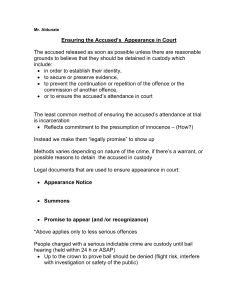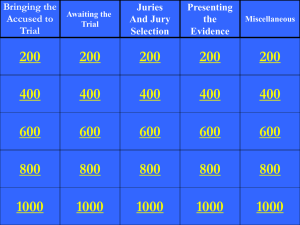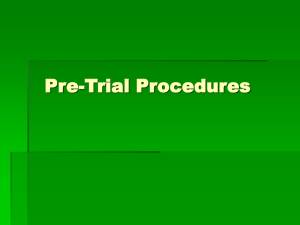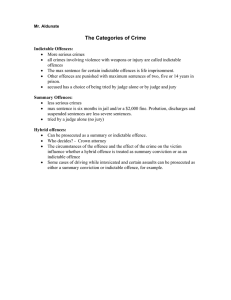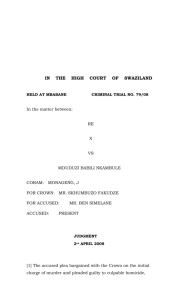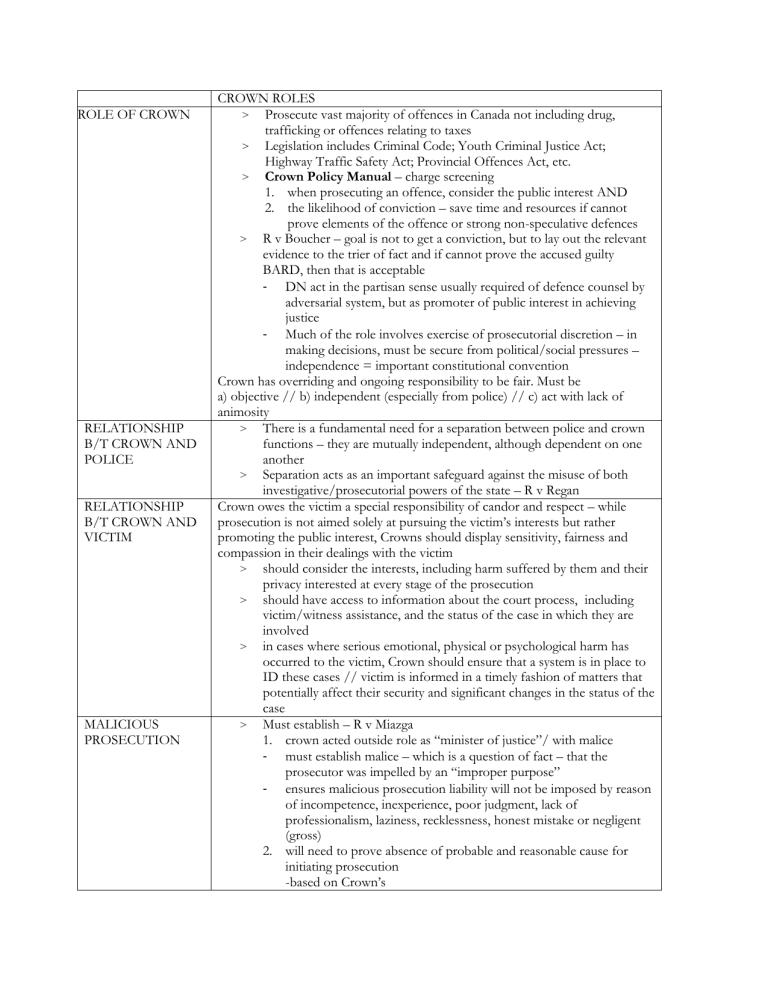
ROLE OF CROWN RELATIONSHIP B/T CROWN AND POLICE RELATIONSHIP B/T CROWN AND VICTIM MALICIOUS PROSECUTION CROWN ROLES > Prosecute vast majority of offences in Canada not including drug, trafficking or offences relating to taxes > Legislation includes Criminal Code; Youth Criminal Justice Act; Highway Traffic Safety Act; Provincial Offences Act, etc. > Crown Policy Manual – charge screening 1. when prosecuting an offence, consider the public interest AND 2. the likelihood of conviction – save time and resources if cannot prove elements of the offence or strong non-speculative defences > R v Boucher – goal is not to get a conviction, but to lay out the relevant evidence to the trier of fact and if cannot prove the accused guilty BARD, then that is acceptable - DN act in the partisan sense usually required of defence counsel by adversarial system, but as promoter of public interest in achieving justice - Much of the role involves exercise of prosecutorial discretion – in making decisions, must be secure from political/social pressures – independence = important constitutional convention Crown has overriding and ongoing responsibility to be fair. Must be a) objective // b) independent (especially from police) // c) act with lack of animosity > There is a fundamental need for a separation between police and crown functions – they are mutually independent, although dependent on one another > Separation acts as an important safeguard against the misuse of both investigative/prosecutorial powers of the state – R v Regan Crown owes the victim a special responsibility of candor and respect – while prosecution is not aimed solely at pursuing the victim’s interests but rather promoting the public interest, Crowns should display sensitivity, fairness and compassion in their dealings with the victim > should consider the interests, including harm suffered by them and their privacy interested at every stage of the prosecution > should have access to information about the court process, including victim/witness assistance, and the status of the case in which they are involved > in cases where serious emotional, physical or psychological harm has occurred to the victim, Crown should ensure that a system is in place to ID these cases // victim is informed in a timely fashion of matters that potentially affect their security and significant changes in the status of the case > Must establish – R v Miazga 1. crown acted outside role as “minister of justice”/ with malice - must establish malice – which is a question of fact – that the prosecutor was impelled by an “improper purpose” - ensures malicious prosecution liability will not be imposed by reason of incompetence, inexperience, poor judgment, lack of professionalism, laziness, recklessness, honest mistake or negligent (gross) 2. will need to prove absence of probable and reasonable cause for initiating prosecution -based on Crown’s 1st PARTY DISCLOSURE – R v STINCHCOMBE Crown Disclosure Obligations (Stinchcombe) Stinchcombe recognized a general duty on the Crown to disclose all materials that is in its possession or control, regardless of whether the evidence is to be called at trial or is inculpatory or exculpatory. Rationale: based on the idea of fair play between parties and the right to make a full answer and defence. NB: Crown obligation is ongoing/continuous – it survives the trial and includes any information which there is a reasonable possibility that it may assist the appellant in prosecuting an appeal Stinchcombe BUT RECALL: Defence have an obligation to diligently pursue disclosure by actively seeking and pursuing disclosure once they become aware or ought to have been aware of it (can’t just stand up at trial and say, they never gave it) If Crown refuses disclosure, defence can seek review from a TJ On review, TJ must be guided by the general principle that information ought not be withheld if there is a reasonable possibility that withholding of info will impair the right of the accused to make full answer and defence Limits on Crown Duty to Disclose Once defence has invoked right to disclosure the onus is on the Crown to comply with the obligation BUT Crown may refuse to disclose following information: Clearly irrelevant material (but note Crown must err on side of disclosure) Information not in the control/possession of the Crown Intoxilizer maintenance records not considered 1st party disclosure – R v Vallentgoard ABCA 2016, R v Jackson ONCA 201 > Police misconduct records may be 1st party disclosure where relevant to the case – R v McNeil Application Procedure: 1. Accused obtains a subpoena duces tecum under ss. 698(1) and 700(1) of Code and serves it on third party record holder – Subpoena compels person to attend court with records 2. Accused brings an application (with affidavit evidence) showing that records are likely to be relevant Notice of application given to Crown, person who’s subject to records, and any other person with privacy interest *EXAM: Hinted that this was important o E.g. the complainant whose records are being disclosed, the hospital and counsel, the doctor and counsel) If record holder or someone with privacy interest advances claim that the documents are privileged then privilege will bar application for production (But consider McClure Innocence at Stake exception) > 3rd PARTY RECORDS Information that would undermine privacy interests Privileged information Time-sensitive information o Example: Ongoing investigation may be protected through redaction of witness information/police techniques etc. Counsel for the complainant is often appointed by Legal Aid (NOT Crown) 3. Application is brought before judge seized with trial (if production is contested; if not contested production is moot and no hearing necessary) 4. If privilege is not an issue, then judge applies two stage O’Connor Test Stage 1: Determine whether the accused has established that the record is likely relevant (i.e. there is a reasonable possibility that the information if logically probative to an issue at trial or competence of a witness to testify) such that it should be given to judge to inspect o Burden is significant but not onerous – no balancing; reflects gate-keeper function Stage 2: If likely relevant, the record is given to the judge to inspect o Judge inspect record to determine whether it should be produced in part or in whole to accused o Involves balancing: judge must examine and weigh the salutary and deleterious effects of production and determine whether non-production would constitute a reasonable limit on ability of accused to make full answer and defence o Factors considered include: Extent to which record is necessary for accused to make full answer/defence Probative value of record Nature and extent of REP vested in record Whether production would be premised upon any discriminatory belief or bias Potential prejudice to complainant’s dignity/privacy NB: Last two tailored to sexual assault proceedings and likely of little assistance o NOTE: If claim of likely relevance is borne out, accused’s right to make full answer and defence will, with few exceptions, tip the balance in favour of allowing the application for production. o STEPS IN CRIMINAL PROCEDURE CRIMINAL PROCEDURE Four Stages of the criminal process 1. investigative – crime committed // police lay a charge // information given to Crown – they decide whether to prosecute, whether alternative measures are appropriate, whether to proceed indictable/summary if summary 2. pre-trial – accused shows up – if in custody they have a bail hearing, if they have been previously released, they have an arraignment // plead guilty or innocent // if guilty – go to sentencing, if not guilty, goes to trial // if indictable offence, accused elects for trial by judge alone or with jury // ptre-trial motions are made ie. Expert opinions, disclosure, etc. // preliminary hearing if indictable and elected by accused – used to determine whether is enough evidence to require a trial – judge decides if there is a reasonable likelihood of conviction PRELIMINARY HEARINGS MENS REA + ACTUS REUS SUMMARY VERSUS INDICTABLE OFFENCES PRE-TRIAL RELEASE 3. trial – found guilty BARD, goes to sentencing // found not guilty BARD, goes free 4. post-trial – appeal if either party doesn’t like the outcome Preliminary hearings are heard on indictable offences and used to establish whether the crown and defense have enough to continue to trial – it is a great way to decide whether making a plea might be the best thing for the accused Standard is essentially whether there is admissible evidence that a jury could justify a conviction on The judge will decide at the end if it is worth going to trial ie. Whether the evidence can hold up to where it needs to be – but even if they say that the evidence is weak, can still continue, you might know where the strengths and weaknesses of your case are > Actus reus concerns the “external elements” of the offence – it is an act/omission of the accused that is required as proof of the offence – criminal law only punishes those acts which are conscious and voluntary > Mens rea is the ‘guilty mind’ when commiting the crime – the intention or knowing that what is being done is wrong – that is why individuals with mental illness cannot be found guilty b/c they cannot have formed the required intent Summary - punishment set out in s.787 CC: up to 6 months jail and/or $5000 fine - no fingerprints submitted - no election for judge and jury if proceed to trial - appeals on summary conviction offences go first to the highest trial court w/i the jurisdiction; after superior court, goes to ONCA and then to SCC which is rarely allowed - eligible for an automatic pardon after 3 years provided accused is not convicted of any further offences in the period Indictable - punishment ranges from: NO minimum to life imprisonment - if offence = hybrid, Crown MUST elect whether to proceed summarily or indictably; have this election endorsed on the information - accused has to submit fingerprints when required to appear to answer to an indictable offence - accused has to determine whether they want to be tried by judge alone or judge and jury - appeals go to ONCA and then to the SCC - accused convicted under an indictable offence can apply for pardon after 5 years > Grounds for Detention – s.515(10) a) Primary grounds – to ensure court attendance -failure to appear in the past, isn’t from the area… b) Secondary grounds – to protect public and prevent accused from committing further offences or interrupting with the administration of justice - Crown must establish likelihood of re-offense + safety risk/concern for administration of justice c) Tertiary grounds – maintain public confidence in the administration REVERSE ONUS UNREPRESENTED ACCUSED VOIR DIRE of justice i) strength of Crown’s case ii) gravity of offence iii) circumstances surrounding the offence ie. Gun used iv) lengthy sentence if convicted - R v St Cloud SCC – tertiary grounds are not to be used sparingly or where other grounds DN measure up – videotape evidence was strong in this case - R v Hall – had strong DNA evidence against the accused > onus is generally on the Crown to show cause why the accused should not be released on bail – in some cases, onus is switched o accused commits an indictable offence while on bail for another indictable offence // o individual who is not ordinarily a resident of Canada is charged with an indictable offence // o charged with failing to comply with condition of recognizance/undertaking for a charge that is still pending // o charged with trafficking/possession for the purpose of doing so o charged with weapons offence while under weapons prohibition o charged with an offence under section 469 o charged with organized crime or terrorism offence > Some matters may have an obligation attached that a lawyer must represent them > Can be challenging to ensure a fair and efficient trial where the accused was unrepresented or self-represented > Have to make sure the accused is given all of the disclosure so that they have the ability to make a full answer and defence > R v McGibbon: Trial judge is required, within reason, to provide assistant to the unrepresented accused – aid him/her in the proper conduct of the defence and guide them through the trial – how far the judge will assist is a matter of discretion > Judge may appoint amicus curiae or counsel If staying a charge Must tell the judge so that the charge can be officially stayed on the accused’s record Section 579 – at any time the AG or counsel instructed by the AG may direct the clerk or officer of the court to make an entry on the accused’s record that the proceedings are stayed > Referred to as a “trial within a trial” - Necessary where evidence must be called to resolve a preliminary question of fact before the judge can make a ruling – used when about to lead evidence that may or may not be admissible OR before the trial starts > Examples of common types of voir dires include o confession voir dires where the Crown must establish BARD that the accused’s statement was made voluntarily as a precondition to its admission into evidence o voir dire as to the admissibility of a hearsay statement where it must be shown that the statement meets the criteria of necessity and reliability o applications for the production of sensitive records under s.278 of the Code (sexual records) where an initial showing that the records STRICT + ABSOLUTE LIABILITY WITNESS FAILS TO ATTENT CONFESSION RULES PURPOSES OF SENTENCING JAIL are likely relevant is necessary before the issue of production can be considered > Strict liability – upon proof by the Crown BARD that actus reus is made out, burden shifts to accused to prove due diligence on BOP – R v SSM - reversal of burden of proof is constitutional; doesn’t breach s.11(d) and is justified under section 1 > Absolute liability – upon proof by the Crown BARD that actus reus is made out, accused is found guilty = NO requirement of mens rea - R v SSM – city allowed pollution in the river – DN matter it was an accident > Most witnesses are compellable – main issue is competence – witness can be subpoenaed to attend the proceedings > If can establish that the witness is highly likely to have material evidence, can ask the court for a “material witness warrant” > Depending on the witness, may need to go ahead without them or determine their necessity to the proceedings and work with defence to plea bargain > Common law confession rule (voluntariness) - At common law (R v Boudreau/Ibrahim), Crown must prove BARD on a voir dire that all statements made by the accused to the person in authority were made voluntarily in order to be found admissible - Assessing voluntariness (R v Oikle) i) threats or promises operating as inducements ii) atmosphere of oppression ie. Deprivation of food iii) lack of operating mind iv) appalling police trickery – “shock the community” SENTENCING Section 718 denounce unlawful conduct; deter offender and other persons from committing offences (specific and general deterrence); separate the offender from the rest of society where necessary; assist in rehabilitation for offenders; promote reparations for harm to victims or the community; promote a sense of responsibility in the offender and acknowledge the harm done punishment must be proportional to the offence – step principle aggravating – race/religion; domestic violence; victim is under 18; offender was in a position of power; significant impact on the victim; criminal record mitigating – youth; shortness or record; good character; remorse; early guilty plea saving the victim having to testify; also have to consider the offender’s Aboriginal status as per Gladue > for a sentence of two years/less, jail is served in provincial institution > can be served intermittently IF sentence is 90 days or less > Truth in Sentencing Act – placed a cap on 1:1 on credit for presentence custody – enhanced credit of a maximum 1.5:1 can be granted “if the circumstances justify it” and the person was not detained b/c of their record Consecutive or Concurrent Sentence - test is whether the acts constituting the offences were part of a linked series of acts within a single endeavor HOWEVER certain offences generally merit consecutive sentences even Kineapple Principle - 2 or more offences (with elements that are substantially the same) committed in RESOLUTION DISCUSSION/ PLEA BARGAINING ANCILLARY ORDERS CONDITIONAL SENTENCE – section 742 OFFENCES the same transaction – Crown will stay the offence(s) with the lesser sentence > New term that essentially describes what is known as plea-bargaining – may include a judge, but generally just a crown, defence and client > Crown cannot accept a guilty plea where they know they cannot prove that the accused committed the offence or an essential element DNA Order: > Primary designated offence – s.487.04 includes offences like aggravated assault, murder etc. > Secondary designated Offence – discretionary – made where the Crown believes it is in the administration of justice to ask for one – offence that has the maximum punishment of imprisonment for 5 years or more OR where the individual is found NCR or convicted, discharged under section 730 or found guilty under the Youth Criminal Justice Act Ancillary orders – may include a prohibition against the possession of weapons, firearms, etc. - usually “keep the peace, and be of good behavior”, peace bonds, etc. > Purposes: reduce society’s reliance on incarceration // give effect to the principles of restorative justice – not to be equated with probation which is a rehabilitative measure > May be imposed for most offences BUT is unavailable for: 1. serious personal injury offences; terrorism/criminal organization offences; prosecuted by indictment that carry a maximum term of imprisonment of 10/more years OR 2. offences punishable by a minimum term of imprisonment > requires that a jail sentence of less than 2 years be imposed in order to consider the application of a CSO Process for CSO (Proulx) > sentencing judge should reject penitentiary term and probationary measures as inappropriate > IF jail sentence of less than 2 years within range THEN judge should consider if it is appropriate that the offender serve the sentence within the community > sentencing judge has to determine that public safety would NOT be jeopardized by imposition of a CSO (condition precedent) 1. risk of offender re-offending 2. seriousness of consequences of any possible re-offending > If sentencing judge = convinced that stat. requirements in s.742.1 satisfied THEN analysis of sentencing principles in s.718 should be undertaken to determine whether CSO is appropriate in circumstances - CSO may express society’s condemnation of offender’s act, this MAY satisfy “denunciation” - Sometimes custodial term of imprisonment will better express punitive objectives - CSO will usually better express rehabilitation, reparation to victim and promote responsibility - CSO not necessary less onerous than “real jail” and terms generally longer in duration that real jail (R v Holmes 2009) > Over 80/Impaired Driving – hybrid offence with increasing of severity of penalties – conditional sentence available - impaired driving is found by observation – when police officer has a TYPES OF EVIDENCE HEARSAY EVIDENCE reasonable suspicion of intoxication – either drinking or drugs, they may pull the individual over - over 80 is discoverable through an intoxilizer > Assault – hybrid – discharge/ suspended sentence/ fine/ fine and probation/ jail/ jail and probation/ jail + fine – can also ask for ancillary orders > Aggravated assault – hybrid offence – ancillary order – max 14 years > Theft – hybrid: summary = 6 months/$5k fine; indictable = 10 years (over $5k) and 2 years (under $5k) > Mischief – hybrid > B + E into a dwelling home = indictable; elsewhere = hybrid > 1st degree murder – planned and deliberate – any offence such as sexual assault, B+E committed while death occurs bumps the offence up to 1st degree – as well if a police officer/prison guard is killed – life in prison with parole at 25 years > 2nd degree murder – deliberate – life in prison with parole at 10 years > manslaughter – not deliberate but foreseeable that death would occur – sentence depends on whether a firearm was involved –culpable homicide that is not murder/infanticide – 4 years and DNA and weapons prohibition = necessary EVIDENCE > Hearsay/Second hand evidence – if not admitted for the truth of its contents or an exception, or the principled approach applies > Direct evidence – evidence going directly to the proof of an actual fact in issue ie. If the only issue at trial is ID and the witness says “I saw him do it” - 2 possible sources of error: witness is lying or mistaken > Circumstantial evidence – inference must be made in order for the evidence to be useful to the trier of fact – DN necessary prove anything ie. Motive, capable of the offence, etc. > Character evidence – where it is relevant such as a defamation case or it is suggesting that the person is of bad character BUT only where the character has been put forward by the defence as being good – have to consider the probative and prejudicial value > Similar fact evidence – presumptively inadmissible – attempts to show that an individual is more likely to have done the offence as they have had similar instances in the past – consider the probative versus prejudicial effect R v Khelawon: 1. an out of court statement is hearsay if 2. it is adduced to prove the truth of its contents AND 3. there is no opportunity for a contemporaneous cross-examination of the declarant > Hearsay = presumptively inadmissible HOWEVER, if hearsay is admitted in evidence, it does not require a limiting instruction b/c the entire purpose of admitting it is to prove the truth of contents Exceptions – before the principled approach BUT presumptively still in place (R v Mapara) > business records exception – Canada Evidence Act s.30 // R v Wilcox > declaration against own interests – R v O’Brien > declaration of present state of mind - R v Griffin - state of mind must be relevant SIMILAR FACT EVIDENCE CIRCUMSTANTIAL EVIDENCE - statement must be made in natural manner - statement must not be made under circumstances of suspicion > dying declarations – R v JR - dying person is assumed reliable as has lost all reason to lie > past recollection recorded – R v JR > prior identification evidence – R v Swanston > res gestae - includes words/phrases that either form part of, or explain, a physical act and exclamations that are so spontaneous as to belie concoction > statement of intent - particular subcategory of a declaration of present state of mind Principled Approach – R v Khelawon > uses a test of necessity and reasonable reliability – means that the hearsay evidence MUST BE 1. necessary - person whose assertion if offered may now be dead, out of jurisdiction or otherwise unavailable for purpose of testing - unable to recollect the information – R v Khan 2. meet a threshold of reliability – R v Khelawon - inherent trustworthiness: circumstances at the time the declaration was made that make it more likely the declarant was being truthful - sufficient testability: circumstances either making the hearsay evidence sufficiently testable by the trier of fact, or which provide adequate substitutes for testability > although presumptively inadmissible, the presumption can be rebutted if the Crown satisfies the trial judge, on a balance of probabilities, that in the context of the particular case the probative value of the proffered evidence with respect to a particular issue outweighs the potential prejudicial effect and thereby justifies its reception – R v Handy Probative Value 1. strength of the evidence that the similar facts happened 2. extent to which the similar fact evidence supports the inference that the Crown wants the trier of fact to draw 3. extent to which the SFE is a material issue Prejudicial Value Moral prejudice – concern that the prohibited inference will be made or that the jury will punish the accused for past unpunished deeds Reasoning prejudice – unduly complicating the trial with additional facts/issues; asking the accused to defend periods of life not at issue in trial Key issue: collusion which goes to the heart of probative value – air of reality of collusion triggers burden of proof on Crown to show that there was no collusion > Corbett Application - defence applies to have accused’s record excluded from the record or parts of it censored - criminal record usually considered admissible – in determining whether to censor it, look at nature of the conviction; remoteness in time before court; boils down to credibility contest; record suggests person would lie under oath > Any evidence from which one or more inferences have to be drawn to establish material facts No burden to prove every piece on a standard BARD, in order to convict on a circumstantial case, judge must be satisfied BARD that the only rational inference drawn from the circumstantial evidence is one of guilt – R v Griffin 2009 SCC > Circumstantial evidence may be used to support the inference of innocence as well as guilt so long as the probative value outweighs prejudicial effect and it is not given undue weight > Examples: motive // opportunity // means, capability // post-offence conduct // knowledge and state of mind Mohan Factors - logical relevance of the expert’s opinion - necessary in assisting the trier of fact - expert is properly qualified - no exclusionary rules prevent the evidence from being admitted Prior inconsistent statements are admissible subject to limitations imposed by sections 10 and 11 of the Canada Evidence Act Can bring an inconsistent statement to a witnesses attention at trial and give them the opportunity to explain the inconsistency If the witness doesn’t adopt the it, then all that can be shown is that there is an inconsistency and this goes to the witness’ credibility – best way to impeach them KGB application – where witness recants from a prior statement and adopts a new version of events CHARTER Charter sections 8 - Everyone has the right to be secure against unreasonable search or seizure o DN apply to every S/S, rather the right focuses on the action being unreasonable on the basis that it violates the expectation of privacy that a reasonable person would have - at CL, when police carry our lawful arrest, they have authority to carry a search incident to arrest – without needing separate and additional grounds for the search – must be connected to a criminal justice objective and must not be abusive or used to intimidate – Cloutier o Individuals have different expectations of privacy depending on where the search occurs – R v Feeney SCC found that entry into a private home w/o a warrant constitutes a violation of s.8 o Seizure = “taking of a thing from a person by a public authority w/o that person’s consent” – R v Dyment (took blood while unconscious and charged with over 80) Charter section 24 (1) anyone whose rights or freedoms, as guaranteed by this Charter, have been infringed or denied may apply to a court of competent jurisdiction to obtain such remedy as the court considers appropriate and just in the circumstances (2) Where, in proceedings under ss.1, a court concludes that evidence was obtained in a manner that infringed or denied any rights or freedoms, the evidence shall be excluded if it established that, having regard to all circumstances, the admission of it in the proceedings would bring the administration of just into disrepute > EXPERT OPINIONS INCONSISTENT STATEMENTS SEARCH + SEIZURE R v Grant factors determine whether admitting evidence would bring the administration of justice into disrepute on BOP 1. seriousness of the breach 2. impact of the breach on the protected interests of accused 3. society’s interests in the adjudication of the case on its merits Section 7 – right to life, liberty and security of the person – includes the right to make full answer and defence // requirement of mens rea // right to silence Section 9 – right to not be arbitrarily detained or imprisoned Section 10 – Everyone has to the right on arrest/detention a) to be informed promptly of the reasons b) to retain and instruct counsel without delay and be informed of the right to do so c) to have the validity of the determined and be released if not lawful - section 10 is only triggered by an arrest/detention – R v Grant states that detention refers to a suspension of an individuals liberty interest by a significant physical or psychological restraint Section 11 – protects a person’s legal rights in criminal and penal matters – includes both criminal as well as regulatory offences a) Any person charged with an offence… has the right to be informed without unreasonable delay of the specific offence b) … to be tried within a reasonable time o criteria set out in R v Askov + R v Morin – accused bears a certain onus to demonstrate actual prejudice as a result of delay o R v Finta clarified that the period of “unreasonable delay” begins at the time the charge is laid o R v Jordan 2016 SCC – a delay longer than 18 months from when a charge is laid to the trial’s completion = presumptively unreasonable – any delay by the Crown beyond that time not justified by exceptional circumstances = stay of proceedings c) … not to compelled as a witness - provides a right against self-incrimination – R v Herbert confirms that this right extends to situations where police employ “unfair tricks” such as sending undercover officers to elicit a confession – also R v Oikle d) … to be presumed innocent until proven guilty e) … not to be denied reasonable bail with just cause f) …trial by jury Section 24 o RELEVANT CHARTER SECTIONS
